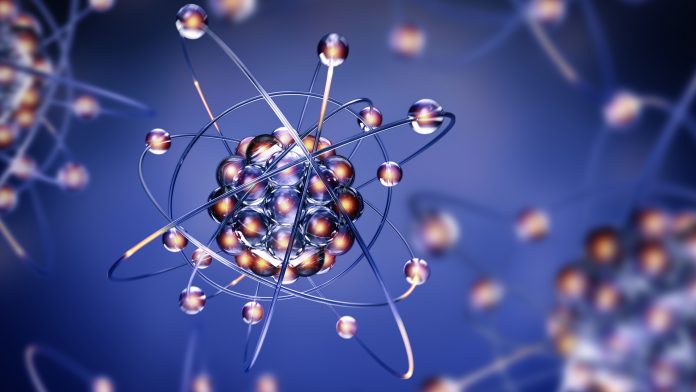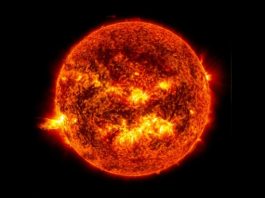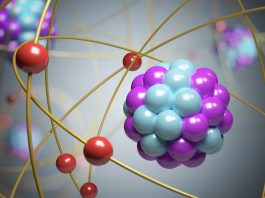The Soreq Applied Research Accelerator Facility is set to be a source of unprecedented fluxes of neutrons and radioactive nuclides.
High-intensity neutron beams and large amounts of radioactive nuclei are powerful tools for exploring uncharted areas of applied and basic science. With no electrical charge and relatively high penetration, neutrons are a unique analysis tool for the understanding and improvement of various components of everyday life such as computer chips, fuels, batteries, plastics, pharmaceuticals, medical devices, nuclear energy via fission and fusion, and much more. Neutrons are further used for basic understanding of nuclear structure and reactions, material science, molecular structure, biological molecules, and can serve as ‘smart bullets’ for destroying cancer cells in the body, with minimal collateral damage to surrounding healthy tissue. Certain radioactive nuclei with distinctive characteristics may be attached to molecules that have affinity to particular organs or diseases in order to diagnose and cure a wide range of ailments. Rarer radioactive nuclei, far away from the valley of stability, are used to investigate the genesis of elements in the Universe, physics beyond the Standard Model of elementary particles, and nuclear structure at extreme ratios of neutron and proton numbers.
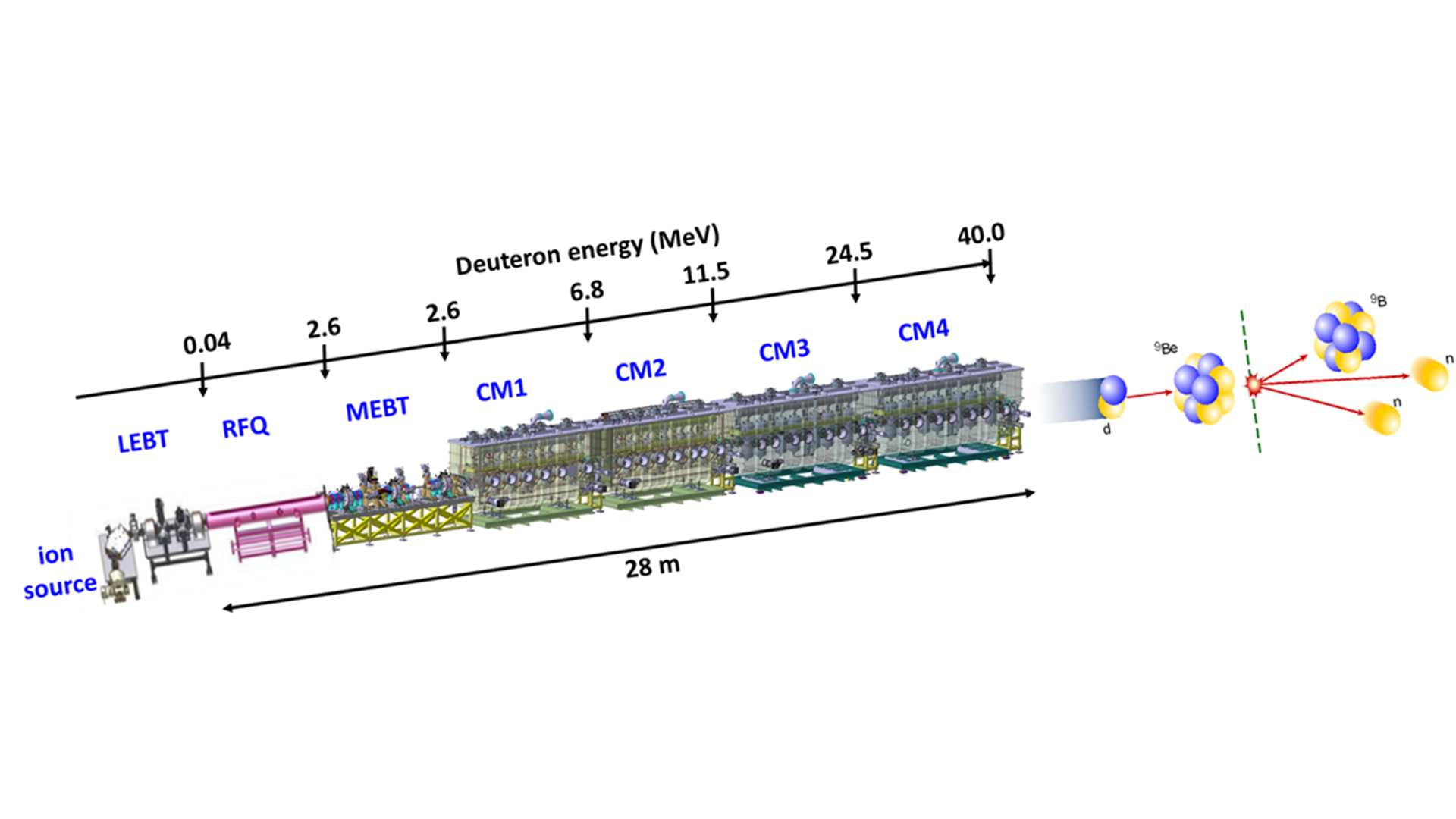
The Soreq Applied Research Accelerator Facility1, currently under construction at Soreq Nuclear Research Center (SNRC) in Yavne, Israel, is based on a medium-energy and high-current superconducting linear accelerator of protons and deuterons. Its cutting-edge specifications, together with unique liquid-metal irradiation targets, make it one of the world-leading sources of neutrons that span the entire energy spectrum from thermal to high energy, and radioactive nuclei from a large portion of the nuclear chart (Fig. 1).
SARAF Phase I
The accelerator and target technologies, which were needed for achieving particle rates that are similar to reactor and high-energy spallation sources, were at their early development stage when the Soreq Applied Research Accelerator Facility was conceived, at the beginning of the century. Therefore, it was decided to divide the accelerator construction into two phases. SARAF-I was built for low beam energy and high current to test and characterise the required novel technologies, and, following its success, was used between 2010 and 2019 for a research programme that utilised its already exceptional beam performance (Fig. 2).
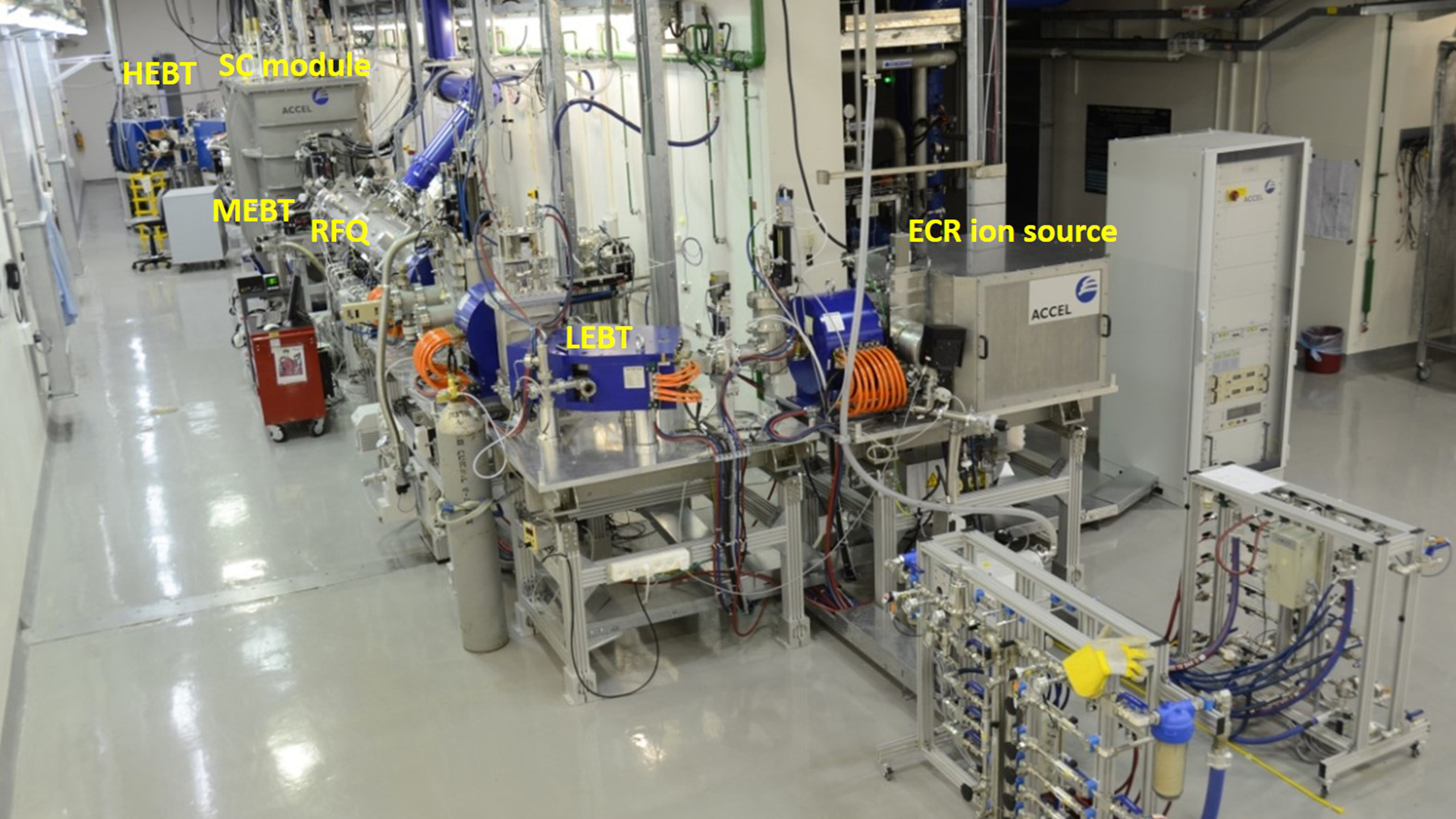
The main irradiation target of the SARAF-I scientific programme was the liquid-lithium jet target (LiLiT).2 This technology is required in order to withstand the extremely high-power density of the Soreq Applied Research Accelerator Facility’s (SARAF) proton and deuteron beams. For the first time ever, a 1.5mm windowless thick liquid-lithium jet was bombarded with an intense beam of protons just above the neutron production threshold, to produce an unprecedented rate of ~1010 neutrons per second, which in turn irradiated a secondary target of interest (Fig. 3).
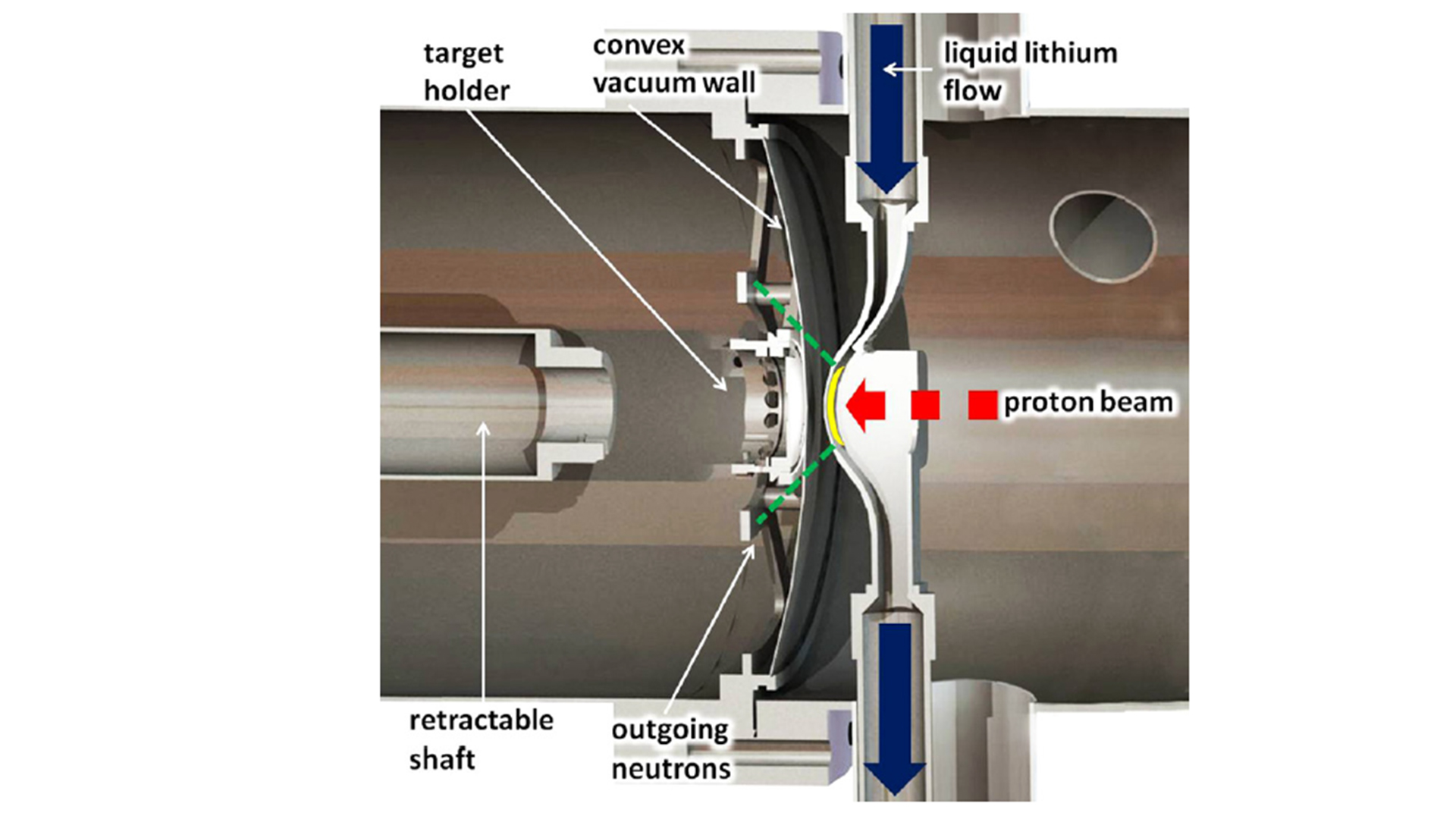
The neutron epithermal energy distribution is very similar to neutrons in the hot environment of asymptotic giant branch stars, thus providing a unique terrestrial laboratory for exploring the slow neutron capture process (s-process) of element synthesis in the Universe (Fig. 4). The exceptionally high rate of neutrons enabled the measurement of this process for rare and even radioactive target isotopes, previously out of reach of conventional neutron sources.3
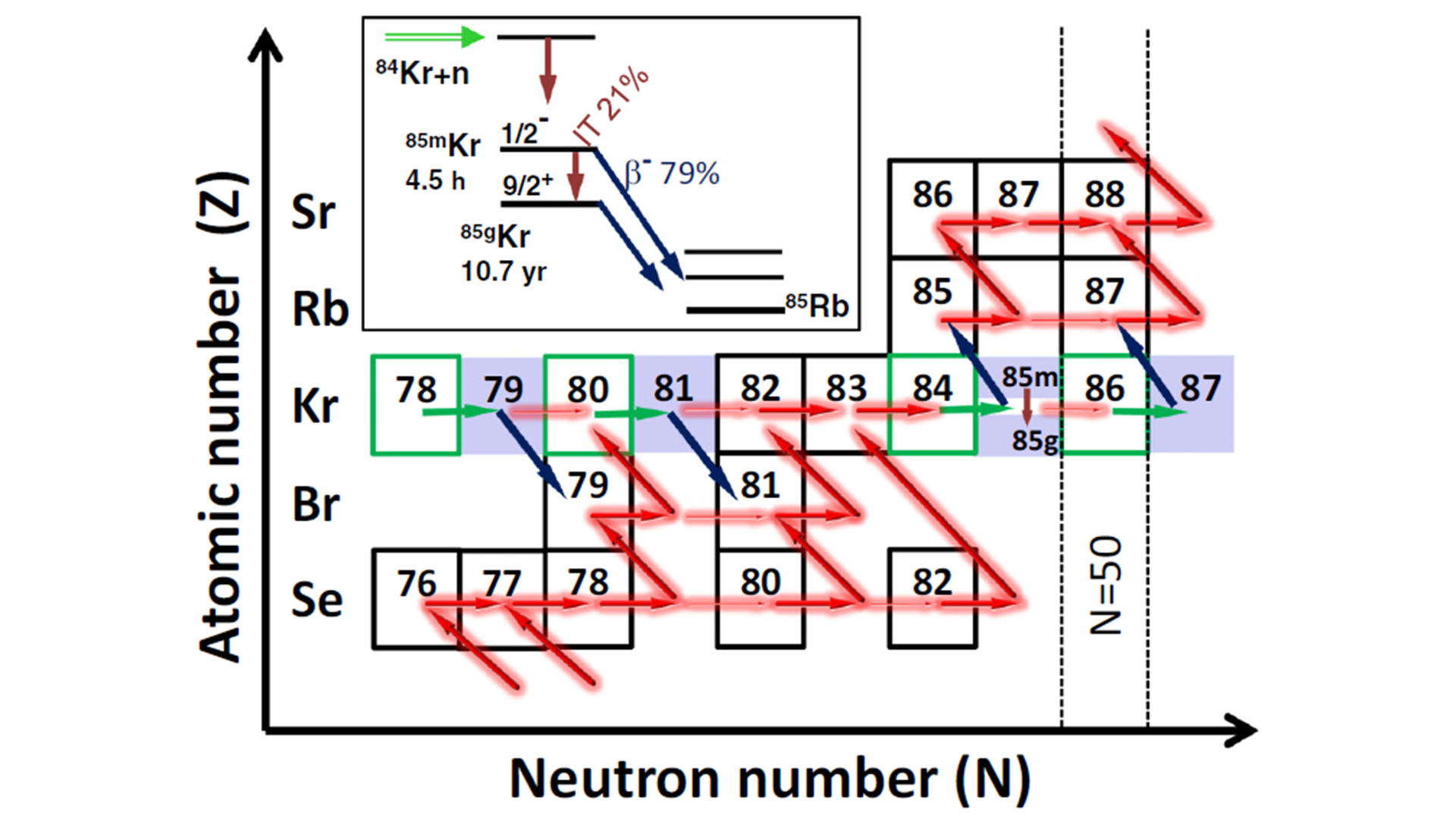
Neutrons from LiLiT were also evaluated for boron neutron capture therapy (BNCT).3,5 Boron, an extremely efficient neutron absorber, is injected as a compound with molecules affine to certain malignant cells. This region is then irradiated externally by epithermal neutrons, the appropriate energy to penetrate the body with minimal damage, and in addition break up the boron atoms to high-impact short-range fragments, which destroy the host malignant cell with hardly any damage to neighbouring healthy ones. The radiotherapy dose should be administered to a patient within an acceptable period of time, thus requiring a high-current proton beam and a liquid-lithium target.
Research in SARAF-I further included the following courses1:
- Feasibility studies of production and trapping of rare light radioactive isotopes such as 6He and 23Ne, in order to precisely study their beta decay patterns and search for signatures of physics beyond the Standard Model of elementary particles;6
- Production of high energy neutrons, up to 20 million electron volts (MeV), from low energy deuterons by irradiation of a special solid lithium-fluoride target;
- Measurement of deuteron-induced cross-sections at low energies for various materials, important for benchmarking nuclear reaction models;
- Investigation of radiation damage due to proton irradiation of tungsten and its alloys, as these are the selected structural materials for future nuclear fusion reactors; and
- Exploration of the extension of gamma radiation dosimeters to measure charged particle doses, and possible usage of nuclear track dosimeters to study the beam halo of SARAF, a major challenge in the safe operation of high intensity accelerators.
SARAF Phase II
The SARAF accelerator is presently being extended to its full capacity. When fully operational, towards the middle of this decade, it will deliver proton and deuteron beams at variable medium energies up to 35 and 40 MeV, respectively, with high currents up to 5 mili-Amperes (1 mili-Ampere ~ 6.2×1015 particles per second) and adjustable beam structure, from long-separated single pulses to continuous-wave (CW). Four irradiation halls are currently under construction (Fig. 5), and the scientific plans in each station are discussed below.
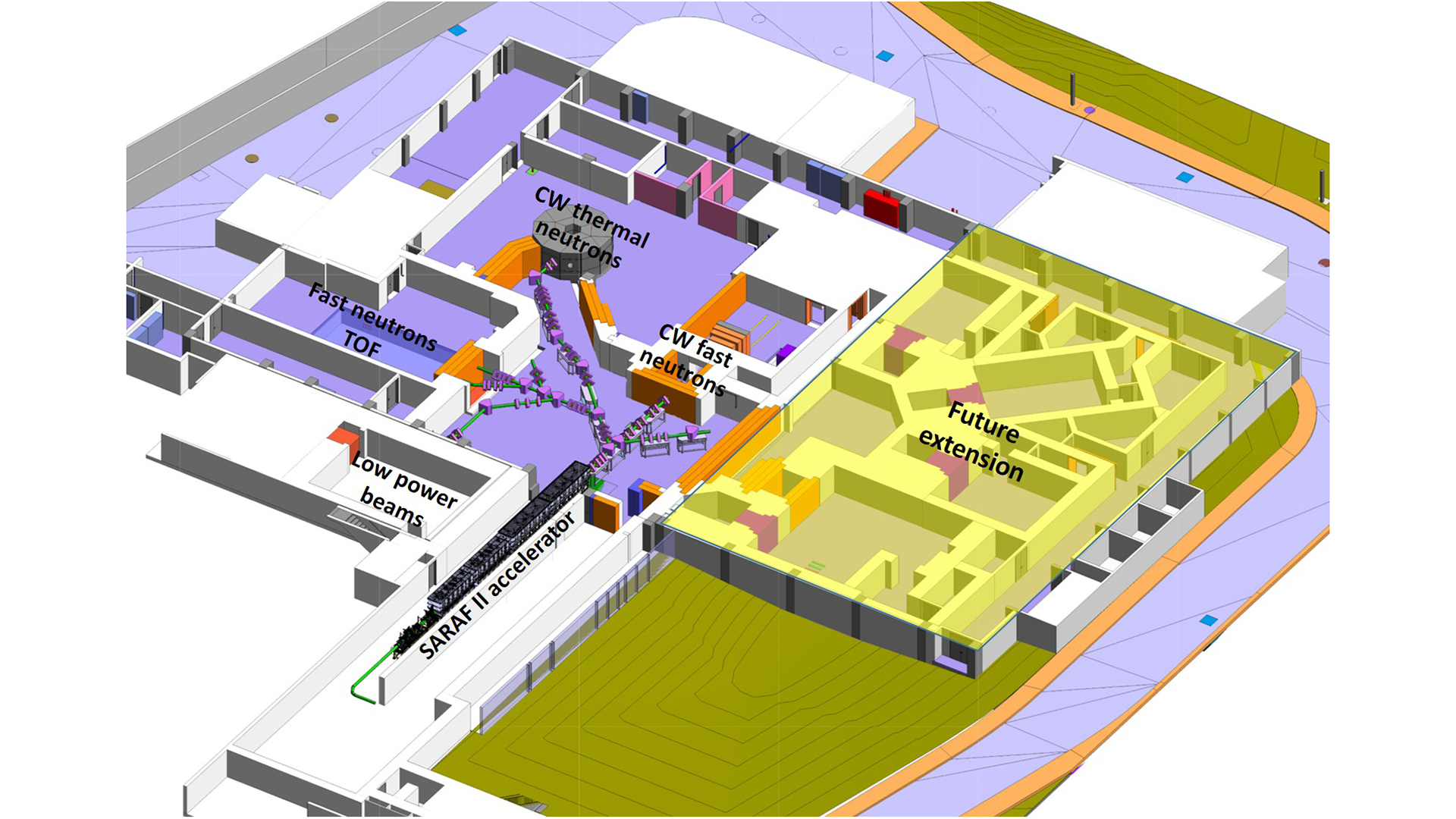
The CW fast neutron station will serve both as a beam-dump for the accelerator, and a source of up to 1015 neutrons per second, with a wide energy spectrum that extends up to ~45 MeV. The beam-dump will be a liquid gallium-indium jet. Even though its neutron rate is about half of lithium, it was favoured since a much thinner film can stop 40 MeV deuterons, and gallium-indium is liquid at room temperature and not hazardous.
We plan to impinge these neutrons on thin natural actinide targets to produce very high amounts of medium-mass neutron-rich rare isotopes via neutron-induced fission, which will in turn be thermalised in a stopping gas cell, separated and forwarded to various measurement devices. A rate of 1010 fissions per second is expected, which will enable the precise measurements of isotopic fission yield distributions and isomer yield ratios at various neutron energy ranges. These values are important for detailed studies of the fission process, and for the design of future nuclear reactors and safe handling of nuclear waste. Mass separation techniques will enable the study of individual neutron-rich rare isotopes in the fission fragment region, with an indicative rate of 106 132Sn ions per second. Detailed studies of rare neutron-rich nuclei is of paramount importance for understanding the astrophysical rapid neutron-capture process (r-process) of element synthesis in the Universe, and the extension of nuclear structure models to regions far away from stability.
CW thermal neutrons will be used for neutron radiography and diffractometry. Neutrons interact with atomic nuclei, whereas x-rays interact with their electron clouds. Therefore, neutron imaging is complementary to x-ray imaging since light nuclei (e.g., H, B) have high thermal neutron attenuation coefficients, whereas heavier elements (e.g., Pb) have relatively smaller ones – an opposite trend to that of x-rays. The thermal neutron source will be used also for neutron activation analysis (NAA) of samples, which is one of the most accurate methods for identifying the material content of a given sample. The expected neutron fluxes at the planned SARAF-II user instruments (e.g. 5×105 neutrons per second per square centimeter at the thermal neutron camera) will be similar to those of a research nuclear reactor of a few megawatts, demonstrating that such medium energy accelerators may serve as reactor alternatives for these applications.
Pulsed fast neutrons at the high rate that is expected at SARAF-II (1012 neutrons per second with a wide spectrum of up to tens of MeV) are extremely useful for the research of basic nuclear reactions and the development and usage of unique imaging techniques. The main advantage of pulsed neutrons is that their energy can be derived from their time of flight between their creation and detection points, thus enabling energy-resolved measurements and images.
Data for nuclear reactions induced by fast neutrons in tens of MeV is quite scarce. In basic research, such data is needed for extending nuclear reaction models to high neutron energies, and understanding the background sources in searches of rare particles and events, such as dark matter and neutrinoless double beta decay. In the applied realm, fast neutron reactions are important for the design of Generation-IV fission reactors and nuclear waste transmutation facilities. In particular, there is interest in the neutron-induced fission and capture cross-sections of long-living trans-uranium elements and fission products, which are the main components of nuclear waste, and may be disposed of by nuclear transmutation to shorter-lived isotopes.
Fast neutrons are also the main source of radiation damage to future fusion reactors, as they are produced at an energy of around 14 MeV in each deuteron-triton fusion event. Research of radiation damage of structure materials via high fluxes of fast neutrons is a major mitigation tool for the operation risks of future fusion reactors. Imaging via fast neutrons enables good contrast over broad densities and atomic numbers, due to their much higher penetration, with respect to thermal neutrons. This is useful for investigation of, for example, dual-phase flow around fuel rods of fission reactors or the study of coolant and lubricant flow in combustion engines.
In the area of low power experiments, we plan to continue nuclear astrophysics s-process research and BNCT studies with an upgraded version of the LiLiT target3, with improved reliability and robustness with respect to the SARAF-I prototype. We will further utilise a low-power version of the liquid gallium-indium target to produce up to 1013 neutrons per second, in order to generate and trap light exotic ions in extensive amounts. Rates in the range of 1011 atoms per second are expected for 6He, 8Li and 18,19Ne. We will trap 6He and 8Li as charged ions in an electrostatic ion trap and excited meta-stable states of neutral Ne isotopes in a magnetic optical trap. The high amount of isotopes will enable precise measurements of the angular correlation of beta-decay daughters of these isotopes (Fig. 6), with an uncertainty that will be small enough to probe effects of physics beyond the Standard Model of elementary particles.6
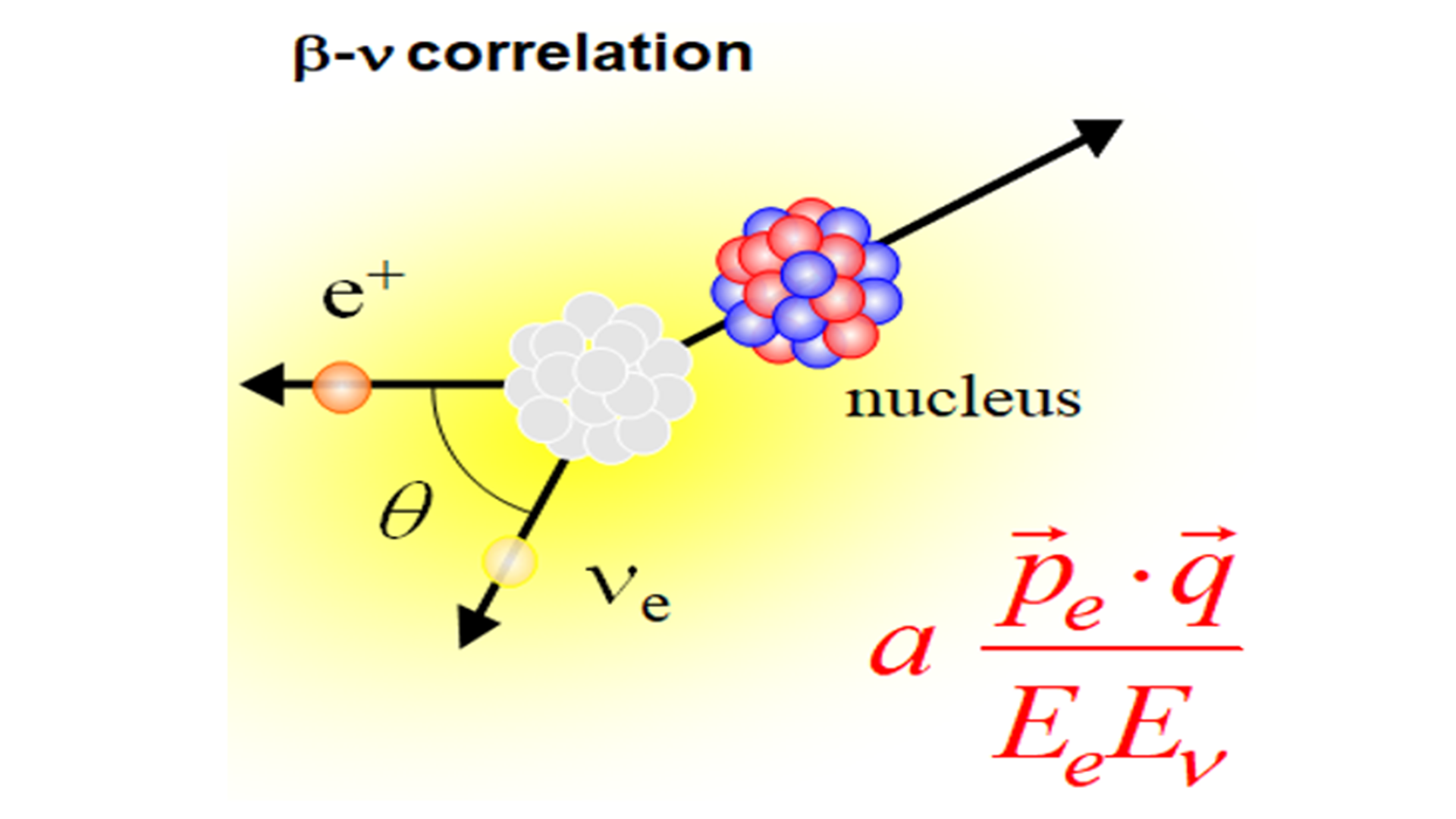
In addition to utilising high neutron fluxes at SARAF-II, we will use the accelerated protons and deuterons directly for various basic and applied research programmes. The current nuclear database on high-energy deuteron-induced cross-sections is very lacking, which significantly limits the reliability and validity of nuclear reaction theories in this region. Deuterons are of special interest due to the importance of the deuteron break up mechanism, making them substantially different from other incident particles. In addition, the assessment of the induced neutron yield and induced radioactivity of accelerator components is vital for efficient and safe accelerator-based neutron sources.
The high and variable beam energy and current specifications for protons and deuterons at SARAF-II make it a unique source of radiopharmaceuticals for nuclear imaging and therapy, which cannot be produced (or are produced with limited amounts) in standard cyclotrons. Furthermore, deuterons provide a way to produce radiopharmaceuticals that are usually a product of high-flux nuclear reactors, of which a large percentage worldwide is aging or is on the verge of shutting down. SARAF-II’s tunable energy and high current will enable efficient production of the wanted radiopharmaceuticals with the highest specific radioactivity and lowest amount of contaminant isotopes that might be toxic, even when rare-material irradiation targets are required.
Radiopharmaceuticals that are considered for production at SARAF-II include medium-mass positron emitters for positron emission tomography (PET), gamma emitters for single photon tomography (SPECT), long-lived generators that are placed in clinics and provide in situ short-lived diagnostic isotopes, and medium- and heavy-mass electron, alpha and low-energy x-ray emitters whose radiation is short-ranged, thus destroying malignant cells with minimal damage to nearby healthy tissue.
Protons, deuterons, and alpha particles (also available at SARAF-II in significant amounts) are also planned to be used for radiation damage studies, exploring the possibility to emulate neutron-induced damage by irradiation with charged particles. Models that link radiation damage from neutron and charged particle irradiation have been pursued in recent years, and experimental irradiation with charged particles may help to confirm them.
Summary and outlook
SARAF-II is currently under construction at SNRC in Yavne, Israel. It will be a new national scientific infrastructure for basic and applied scientific research, which is based on a medium-energy high-power proton and deuteron accelerator, to be completed by the middle of the present decade. It will be the full-capacity extension of SARAF-I, which was operational until 2019. In SARAF-I, we produced worldwide pioneering results in high current superconducting particle acceleration and high-power target irradiation, along with forefront scientific research, especially of the astrophysical s-process of element synthesis in the Universe.
SARAF-II’s cutting-edge beam specifications, combined with its unique liquid-metal target technology, will make this facility competitive with the world’s most powerful deuteron, proton, fast neutron and radioactive isotope sources. It will be a far-reaching probe of the intensity and precision frontier, via studies of exotic isotopes and their decay properties, and measurement of rare processes with very low probabilities, or that require irradiation materials that are available only in minute quantities. High-flux fast-pulsed7 and CW neutron beams at various energies will be used for advanced imaging and measurement of important basic and applied processes.
SARAF-II will be operated as an international user facility, where beam time will be allocated based on scientific merit by a programme advisory committee. We continue to develop the SARAF-II scientific research programme, and look forward to letters of intent and proposals from the international community. More details about the results of SARAF-I and the plans for SARAF-II can be found in reference1 and references therein.
References
1 I Mardor et al., The Soreq Applied Research Accelerator Facility (SARAF): Overview, research programs and future plans, Eur. Phys. J. A (2018) 54: 91
2 S Halfon et al., Note: Proton irradiation at kilowatt-power and neutron production from a free-surface liquid-lithium target, Rev. Sci. Instr. 85, 056105 (2014)
3 M Paul et al., Reactions along the astrophysical s-process path and prospects for neutron radiotherapy with the Liquid-Lithium Target (LiLiT) at the Soreq Applied Research Accelerator Facility (SARAF), Eur. Phys. J. A (2019) 55: 44
4 M Tessler et al., Stellar s-process neutron capture cross-sections on 78, 80, 84, 86Kr determined via activation, atom trap trace analysis, and decay counting, Phys. Rev. C 104, 015806 (2021)
5 M Paul et al., A 50 kW Liquid-Lithium Target for BNCT and Material-Science Applications, EPJ Web of Conf. 231, 03004 (2020)
6 B Ohayon et al., Weak interaction studies at SARAF, Hyperfine Interact. (2018) 239: 57
7 A Shor et al., Fast chopper for single radio-frequency quadrupole bunch selection for neutron time-of-flight capabilities, Phys. Rev. Accel. Beams 22, 020403 (2019)
Please note, this article will also appear in the tenth edition of our quarterly publication.

